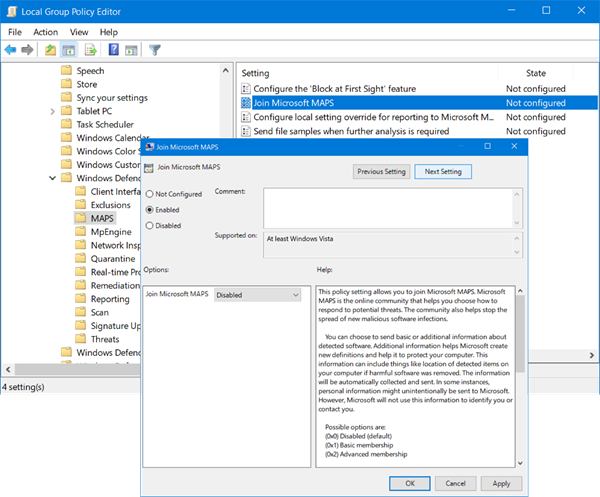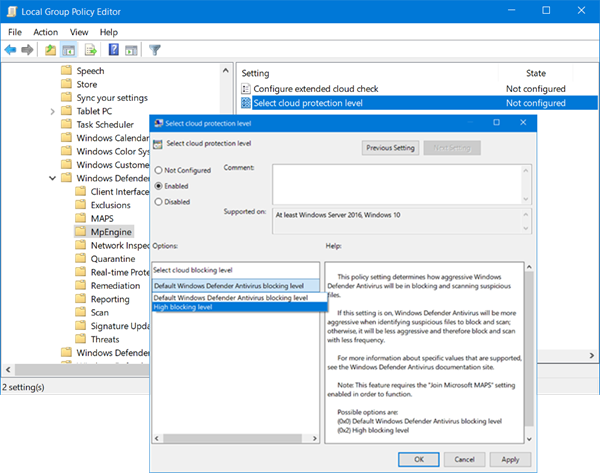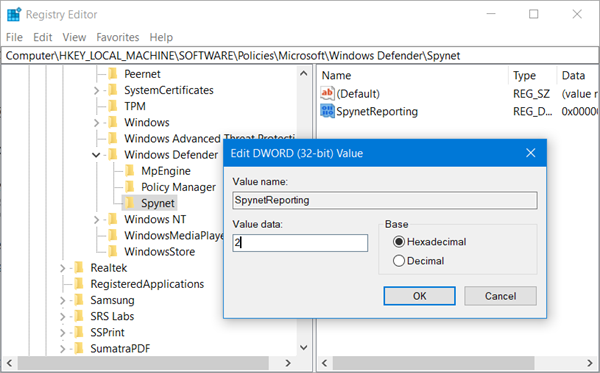In this post, we discuss the best Windows Defender settings to harden protection to the highest levels on your Windows 11/10 computer.
By default, Windows Defender is set in a low protection mode since this will make our lives easy by imposing fewer restrictions, but IT administrators can enable Cloud Protection and change these Group Policy settings – Configure Block at First Sight, Configure local setting override for reporting, and Join Microsoft MAPS (Microsoft Advanced Protection Service) or SpyNet, to set Windows Defender Antivirus blocking protection to highest levels.
Best Windows Defender settings for Windows 11/10
Run gpedit.msc to open the Group Policy Editor and navigate to the following path:
Computer Configuration > Administrative Templates > Windows Components > Windows Defender Antivirus > Maps

Here you will see 4 settings:
- Join Microsoft Maps
- Configure Block at First Sight feature
- Configure local setting override for reporting to Microsoft MAPS
- Send file samples when further analysis is required.
You can configure Windows Defender settings according to your requirements.
1] Join Microsoft Maps
To join Microsoft Advanced Protection Service, double-click on Join Microsoft Maps. In the Properties box which opens, select “Enabled.”
This policy setting allows you to join Microsoft MAPS. Microsoft MAPS is the online community that helps you choose how to respond to potential threats. The community also helps stop the spread of new malicious software infections. You can choose to send basic or additional information about detected software. Additional information helps Microsoft create new definitions and help it to protect your computer. This information can include things like location of detected items on your computer if harmful software was removed. The information will be automatically collected and sent. In some instances, personal information might unintentionally be sent to Microsoft. However, Microsoft will not use this information to identify you or contact you.
You have 3 options here – Disabled, Basic membership and Advanced membership.
2] Configure Block at First Sight feature
After joining MAPS, you can double-click 0n Block at First Sight and select Enabled in its Properties box..
This feature ensures the device checks in real time with the Microsoft Active Protection Service (MAPS) before allowing certain content to be run or accessed. If this feature is disabled, the check will not occur, which will lower the protection state of the device.
This feature requires these Group Policy settings to be set as follows: Join Microsoft MAPS must be enabled, the Send file samples when further analysis is required should be set to Send safe samples or Send all samples, the Scan all downloaded files and attachments policy must be enabled and the Turn off real-time protection policy should NOT be enabled.
3] Configure local setting override for reporting to Microsoft MAPS
The Configure local setting override for reporting to Microsoft MAPS setting will let users take precedence over the Group Policy thus eventually allowing them to override the same.
This policy setting configures a local override for the configuration to join Microsoft MAPS. This setting can only be set by Group Policy. If you enable this setting, the local preference setting will take priority over Group Policy.
You need to double-click on it and select Enabled in the Properties box which opens. Once this feature is enabled it will run checks in real-time and will decide on whether to allow the content to run or not.
4] Send file samples when further analysis is required
The Send file samples when further analysis is required setting will let you send all the samples automatically to Microsoft for further analysis.
This policy setting configures behaviour of samples submission when opt-in for MAPS telemetry is set. The possible options are: Always prompt, Send safe samples automatically, Never send and Send all samples automatically.
You need to double-click on it and select Enabled in the Properties box which opens.
Having done this, you can move on to set the Cloud protection level for Windows Defender.
5] Select Cloud Protection level in Windows Defender

The cloud protection level too can be enabled by using the Group Policy by visiting the following path:
Computer Configuration > Administrative Templates > Windows Components > Windows Defender Antivirus > MpEngine
In the right pane, you will see Select protection level. Double-click on it to open its Properties box and then choose Enabled. You will see two options offered:
- Default Windows Defender Antivirus blocking level
- High blocking level
Select High blocking level and click on Apply.
This policy setting determines how aggressive Windows Defender Antivirus will be in blocking and scanning suspicious files. If this setting is on, Windows Defender Antivirus will be more aggressive when identifying suspicious files to block and scan; otherwise, it will be less aggressive and therefore block and scan with less frequency.
Read: How to enable and configure Ransomware Protection in Windows Defender.
6] Configure extended cloud check
Under the MpEngine settings, you will also see a Configure extended cloud check setting. If you wish, you may also Enable this setting
This feature allows Windows Defender Antivirus to block a suspicious file for up to 60 seconds, and scan it in the cloud to make sure it’s safe. The typical cloud check timeout is 10 seconds. To enable the extended cloud check feature, specify the extended time in seconds, up to an additional 50 seconds.
TIP: Make Windows Defender protect you against Potentially Unwanted Programs too.
7] Enable & set Cloud Protection level to High using Registry

If you are a user of Windows 10 Home, then you can use the Windows Registry and tweak some settings. To do this, type regedit.exe in Start Search and hit Enter to open the Registry Editor. Now navigate to the following key:
HKEY_LOCAL_Machine\Software\Policies\Microsoft\Windows Defender
In the left side, right-click on Windows Defender, select New > Key and name the key Spynet. Right-click on Spynet and again select New > Dword (32-bit) and name it SpynetReporting. Set its value to 2 to set it at Advanced level.
Now, again right-click on the Windows Defender key which appears on the left side and select New > Key. This time name the key as MpEngine. Next right-click on the MpEngine key and select New > Dword (32-bit) value. Name the key as MpCloudBlockLevel and give it a value of 2 to set it at High block level.
Tools that may help you:
- ConfigureDefender helps you change Windows Security settings instantly
- WinDefThreatsView tool lets you set default actions for Windows Defender threats.